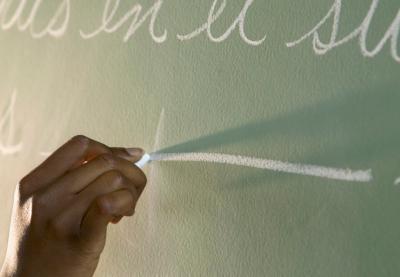This is my 15th year teaching history to high schoolers. However, it was not until my eighth year teaching that I truly understood my purpose in the classroom.
Back in 2009, I was in a devastating car accident. I hit a deer that was standing frozen in the lane; the SUV rolled and I was discovered 30 yards away. I could not feel my right arm. My neck was broken. Doctors call this injury a “hangman’s break”: I was lucky to be alive.
My second cervical vertebra was crushed and had to be rebuilt. With my neck repaired, my focus shifted to my arm. Months—and surgeries—later, I learned that not everything broken can be fixed. Learning to apply mascara without poking myself in the eye and write with my left hand have been the easy adjustments. My right hand and arm would no longer help me carry books, write notes on the board or give an encouraging thumbs-up to my students. I felt funny about standing in front of the class, one arm “talking” about history while the other just hung down. I felt awkward and unnatural, suddenly too concerned about my image. I saw my paralyzed arm as a weakness. How could I be an encouraging and inspiring teacher when I struggled to effectively pass out papers?
As a high school teacher, I had developed a “thick skin” for students’ wayward comments and sometimes adolescent behavior. But how would they respond to an obvious weakness? Would they think of me as weak? Would they be as uncomfortable with my paralysis as I was?
I was stunned by the reception I received from my students. They were elated, proud of my return. While I continued to teach history, they showed me how to hold my pencil, carried books for me and passed out those pesky papers. My students accepted my disability long before I could do so. They were patient and helpful, never indicating that they thought I was less of a teacher. I lost the use of my arm but gained a new respect for my students.
And I discovered that my situation was inspiring to others. Modeling my ability to manage my limitations, accept others staring at me and still be grateful taught my students the power of perseverance through adversity.
I was proud when other teachers began to use my story to teach determination and acceptance. I speak to students about my disability, my struggles and learning to accept that I am different. My message to them: I do have a disability, but I am stronger than ever because of it. Students are often shocked to learn of my paralysis. Sometimes they cannot believe that I function well or that I could have become comfortable with my disability. Some students don’t initially realize that I do not use my right arm. Others openly ask questions. The question I always get is, “Were you right-handed?”
“Yep,” I tell them, and I see the realization spread across their faces before they follow up with questions about how I became left-handed and how difficult that transition was. I usually get a laugh when I tell them that, for a while, my 4-year-old daughter’s handwriting was better than mine.
Sometimes I am able to speak with special education students about my disability. When I do, I emphasize that this journey has been a challenge I never wanted to face. But here it is! So I will make the most of it. I remind them that I was a student with a disability, too: I used a 504 while I was working on my doctorate. This allowed me extra time to complete assignments since I write with my non-dominant hand and I type singlehandedly. It does not mean that I was not capable of completing assignments—it means I complete them differently.
Obviously, I never imagined that my life would so drastically change, and at first I could only see everything that limited me. But so much good has grown out of this incredibly difficult storm; it’s a matter of looking for the silver lining. I am so thankful that I could return to teaching, that my students taught me to accept the inevitable with a grace that matched their kindness. This experience has been—and continues to be—one of my best teaching tools. I am proud that I can use my story to encourage students to overcome adversity.
Cash is a high school social studies teacher in upstate South Carolina.


0 COMMENTS